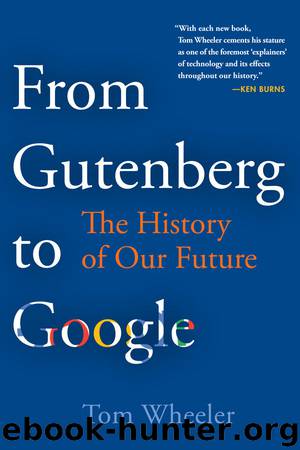From Gutenberg to Google by Tom Wheeler

Author:Tom Wheeler
Language: eng
Format: azw3, epub
ISBN: 9780815735328
Publisher: Brookings Institution Press
Published: 2019-02-26T05:00:00+00:00
Competition and Innovation
In his 1910 report to stockholders Theodore Vail expounded on his vision: a “universal wire system” for the “electronic transmission of intelligence.”33 He was prescient in the synergy between universality and the electronic transmission of intelligence; the analog phone network would become the universal gateway to early digital activity. He was less insightful about the impediment to such innovation that his monopoly created.
Vail’s success in transferring AT&T’s focus away from a competitive marketplace had the effect of creating a sclerosis that hardened the network against change. While competition traditionally drives innovation, the company Vail created had succeeded in eliminating competition and thus could innovate (or not) at its own pace. The universality of the network Vail created may have become the threshold enabler of the information age. Yet that innovation would not occur without a fight, as the monopoly’s antibodies fought against the threat of disruptive innovation.
Under Vail, innovation was to be embraced but controlled. Vail, who had watched as Jay Gould used Edison’s technology to manipulate the activities of Western Union, appreciated how new technology could negatively affect an established business. He saw a means of mitigating such a threat if the company became a technology leader itself. He began a process of expansive technology development that looked into the needs of the future, but on Bell’s terms.34
In 1925, AT&T created Bell Laboratories, which ultimately became home to arguably more IQ per square foot than any other place on the planet. Bell Labs engineers originated ideas as important as Claude Shannon’s in “A Mathematical Theory of Communication,” which envisioned information as a physical quantity to be manipulated. Scientific American called it “the Magna Carta of the information age.”35 Bell Labs was the progenitor of the essential components to fulfill Shannon’s thesis, including the transistor, magnetic storage, and early computer languages.
AT&T became a frenetic propagator of innovation, but a sluggish adopter. While its leaders understood that the nature of networks must ultimately evolve, the first purpose of the corporation was to preserve the market position of the present network. One example of this policy at work was the development of magnetic storage. In the early 1930s a Bell Labs engineer, Clarence Hickman, developed the first answering machine by developing magnetic tape that would record sounds. It was a discovery about the magnetic storage of information with implications far beyond recording a missed phone message. AT&T ordered Bell Labs to cancel Hickman’s research because management worried that if the public had the ability to leave a message people would place fewer phone calls.36
The ultimate tool to exploit the symbiotic relationship between the government and the phone company was a federal rule (actually an FCC-approved tariff describing rates and services) that gave the AT&T monopoly total control over anything that attached to the network. The company used the full force of the federal government to prohibit the use of any “equipment, apparatus, circuit or device not furnished by the telephone company.”37 In a fit of public relations inspiration, such non-Bell devices were labeled “foreign attachments,” or sometimes “alien attachments.
Download
This site does not store any files on its server. We only index and link to content provided by other sites. Please contact the content providers to delete copyright contents if any and email us, we'll remove relevant links or contents immediately.
| Circuits | Digital Design |
| Electric Machinery & Motors | Electronics |
| Fiber Optics | Networks |
| Superconductivity |
Whiskies Galore by Ian Buxton(40299)
Introduction to Aircraft Design (Cambridge Aerospace Series) by John P. Fielding(32331)
Small Unmanned Fixed-wing Aircraft Design by Andrew J. Keane Andras Sobester James P. Scanlan & András Sóbester & James P. Scanlan(32136)
Craft Beer for the Homebrewer by Michael Agnew(17439)
Turbulence by E. J. Noyes(7032)
The Complete Stick Figure Physics Tutorials by Allen Sarah(6631)
Kaplan MCAT General Chemistry Review by Kaplan(6044)
The Thirst by Nesbo Jo(5778)
Bad Blood by John Carreyrou(5761)
Learning SQL by Alan Beaulieu(5399)
Weapons of Math Destruction by Cathy O'Neil(5030)
Man-made Catastrophes and Risk Information Concealment by Dmitry Chernov & Didier Sornette(4728)
iGen by Jean M. Twenge(4694)
Digital Minimalism by Cal Newport;(4511)
Life 3.0: Being Human in the Age of Artificial Intelligence by Tegmark Max(4493)
Audition by Ryu Murakami(4091)
1,001 ASVAB Practice Questions For Dummies by Powers Rod(4034)
Electronic Devices & Circuits by Jacob Millman & Christos C. Halkias(4021)
Pale Blue Dot by Carl Sagan(3996)
